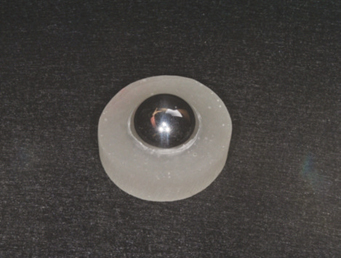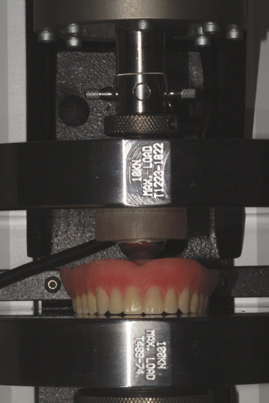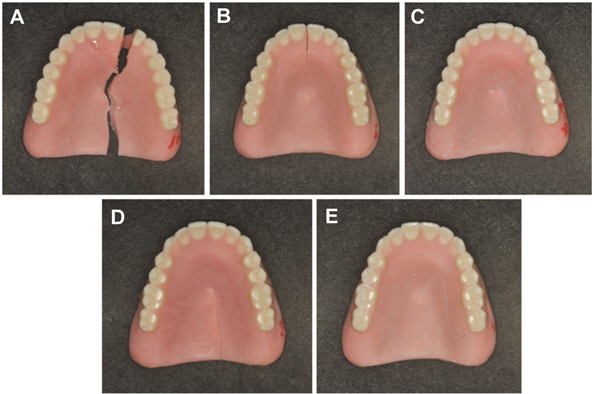J Korean Acad Prosthodont.
2012 Oct;50(4):279-284. 10.4047/jkap.2012.50.4.279.
Effect of location of glass fiber pre-impregnated with light-curing resin on the fracture strength and fracture modes of a maxillary complete denture
- Affiliations
-
- 1Department of Prosthodontics, School of Dentistry, Pusan National University, Yangsan, Korea. neoplasia96@hanmail.net
- 2One Dental Lab., Ltd, Pusan, Korea.
- KMID: 2195469
- DOI: http://doi.org/10.4047/jkap.2012.50.4.279
Abstract
- PURPOSE
This study evaluated the effect of glass fiber pre-impregnated with light-curing resin on the fracture strength and fracture modes of a maxillary complete denture.
MATERIALS AND METHODS
Maxillary acrylic resin complete dentures reinforced with glass fiber pre-impregnated with light-curing resin (SES MESH, INNO Dental Co., Yeoncheon-gun, Korea) and without reinforcement were tested. The reinforcing material was embedded in the denture base resin and placed different regions (Control, without reinforcement; Group A, center of anterior ridge; Group B, rugae area; Group C, center of palate; Group D, full coverage of denture base). The fracture strength and fracture modes of a maxillary complete denture were tested using Instron test machine (Instron Co., Canton, MA, USA) at a 5.0 mm/min crosshead speed. The flexure load was applied to center of denture with a 20 mm diameter ball attachment. When fracture occurred, the fracture mode was classified based on fracture lines. The data were analyzed with one-way ANOVA at the significance level of 0.05.
RESULTS
There were non-significant differences (P>.05) in the fracture strength among test groups. Group A showed anteroposterior fracture and posterior fracture mainly, group B, C and control group showed partial fracture on center area mostly. Most specimen of group D showed posterior fracture.
CONCLUSION
The location and presence of the fiber reinforcement did not affect the fracture strength of maxillary complete denture. However, reinforcing acrylic resin denture with glass fiber has a tendency to suppress the crack.
Figure
Reference
-
1. Yoshida K, Takahashi Y, Shimizu H. Effect of embedded metal reinforcements and their location on the fracture resistance of acrylic resin complete dentures. J Prosthodont. 2011. 20:366–371.
Article2. Smith LT, Powers JM, Ladd D. Mechanical properties of new denture resins polymerized by visible light, heat, and microwave energy. Int J Prosthodont. 1992. 5:315–320.3. Jeong CM. A comparative study on the several metal reinforcement methods of maxillary complete acrylic resin denture base. J Korean Acad Prosthodont. 1996. 34:363–372.4. Morris JC, Khan Z, von Fraunhofer JA. Palatal shape and the flexural strength of maxillary denture bases. J Prosthet Dent. 1985. 53:670–673.
Article5. Lambrecht JR, Kydd WL. A functional stress analysis of the maxillary complete denture base. J Prosthet Dent. 1962. 12:865–872.
Article6. Vallittu PK, Lassila VP, Lappalainen R. Evaluation of damage to removable dentures in two cities in Finland. Acta Odontol Scand. 1993. 51:363–369.
Article7. Vallittu PK, Lassila VP. Reinforcement of acrylic resin denture base material with metal or fibre strengtheners. J Oral Rehabil. 1992. 19:225–230.
Article8. Narva KK, Lassila LV, Vallittu PK. The static strength and modulus of fiber reinforced denture base polymer. Dent Mater. 2005. 21:421–428.
Article9. Vallittu PK. Glass fiber reinforcement in repaired acrylic resin removable dentures: preliminary results of a clinical study. Quintessence Int. 1997. 28:39–44.10. Narva KK, Vallittu PK, Helenius H, Yli-Urpo A. Clinical survey of acrylic resin removable denture repairs with glass-fiber reinforcement. Int J Prosthodont. 2001. 14:219–224.11. Pollet JC, Burns SJ. An analysis of slow crack propagation data in PMMA and brittle materials. Int J Fract. 1977. 13:775–786.
Article12. Ezrin M. Failure analysis and test procedures. Plastics Failure Guide. 1996. Cincinnati, OH, USA: Hanser Gardner Publ;210–225.
Article13. Huang GC, Lee CH, Lee JK. Thermal and mechanical properties of short fiber-reinforced epoxy composites. Polym Korea. 2009. 33:530–536.14. Shin IJ, Lee DJ. Reinforcing characteristics of ductile short-Fiber in brittle matrix composites. Trans KSME A. 2000. 24:250–258.15. Jang J, Han S. Mechanical properties of glass-bre mat/PMMA functionally gradient composite. Trans Korean Soc Mech Eng. A. 1999. 30:1045–1053.
Article16. Gurbuz O, Unalan F, Dikbas I. Comparative study of the fatigue strength of five acrylic denture resins. J Mech Behav Biomed Mater. 2010. 3:636–639.
Article17. Michael CG, Javid NS, Colaizzi FA, Gibbs CH. Biting strength and chewing forces in complete denture wearers. J Prosthet Dent. 1990. 63:549–553.
Article
- Full Text Links
- Actions
-
Cited
- CITED
-
- Close
- Share
- Similar articles
-
- Comparison of metal wire reinforcement and glass fiber reinforcement in repaired maxillary complete denture
- Comparison of the fracture resistances of glass fiber mesh- and metal mesh-reinforced maxillary complete denture under dynamic fatigue loading
- Evaluation of mechanical properties of several dual-cure resin cements by curing modes
- EFFECTS OF CHOPPED GLASS FIBER ON THE STRENGTH OF HEAT-CURED PMMA RESIN
- Strength of glass fiber reinforced PMMA resin and surface roughness change after abrasion test







